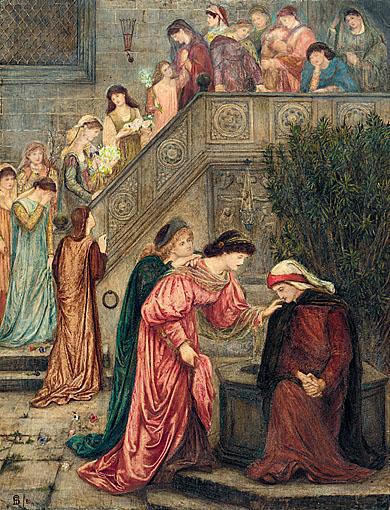As Dante Gabriel Rossetti was working on his last paintings of Dante’s beloved Beatrice, in the couple of years before his death, two other artists associated with the Pre-Raphaelites were also at work on their depictions of her. Henry Holiday was researching for his 1883 painting Dante meets Beatrice at Ponte Santa Trinita, which I showed in the first article in this series, and Marie Spartali Stillman painted the first of her several watercolours of Dante and Beatrice.
Marie Spartali, as she was before her marriage in 1871, was one of a trio of beautiful young women from Greek migrant families in London who had become known as the Three Graces. Her father, then a wealthy merchant, entertained Pre-Raphaelite painters including Rossetti, the latter referring to Marie as a “stunner”.
The Three Graces modelled for the artists of the day, and Marie appears as one of the figures in Rossetti’s painting of Dante’s Dream on the Day of the Death of Beatrice (1871, 1880). She learned to paint in private lessons from Ford Madox Brown, and was soon making her own images based on the writings of Dante, and Rossetti’s translations of them into English.

The full title of her “Certain ladies of her companionship gathered themselves unto Beatrice…” (1880) actually quotes even more from Dante’s Vita Nuova:
Certain ladies of her companionship gathered themselves unto Beatrice where she kept alone in weeping. And as they passed in and out, I would hear them speak concerning her, how she wept.
This refers to the ladies of Florence who paid their respects to Beatrice as she kept vigil following her father’s death. Dante is shown sat outside the house, wearing his customary chaperon hat, his head bowed, and being comforted by two of the women who had visited Beatrice inside.

In 1896, Marie Spartali Stillman revisited Dante’s Vita Nuova through Dante Gabriel Rossetti’s popular translation into English. Her earlier version of Beatrice (1896) shows Dante’s beloved Beatrice lost in contemplation while reading, an intimate insight set firmly in the Pre-Raphaelite mediaeval.


Her second treatment of Beatrice (1898) employs similar floral language, perhaps emphasising innocence in its lilies, but is less contemplative and more sensual, in a manner perhaps more typical of Rossetti.

In the months before the outbreak of the First World War, she painted The Pilgrim Folk (1914), which may well have been a double valediction, as both her last major painting and her farewell to Italy. It again refers to Dante’s Vita Nuova via Rossetti, a quotation from which was shown with the painting. This passage contains Dante’s account of Beatrice’s death to a group of newly-arrived pilgrims.
Dante leans out from a window at the left, addressing three pilgrims below. At the lower left corner, the winged figure of Love crouches in grief, poppies scattered in front of him, a reference to Rossetti’s paintings. Pilgrims around the well are taking refreshment after their travels, and more are arriving through the alley beyond. Black crows fly in flocks above, symbolising death. The landscape behind is very Italian, and the whole has a fairy-tale unreality about its mediaeval details.
Stillman had used Rossetti’s symbols elsewhere too, including in what I consider to be her finest painting, Love’s Messenger completed in 1885, three years after his death.

A young woman stands by her embroidery at an outside window. On her right hand is a messenger dove/pigeon, to which a letter is attached. She clutches that letter to her breast with her left hand, implying that its contents relate to matters of the heart. The dove is being fed corn, which could either be its reward for having reached its destination (thus the woman is the recipient of the message), or preparation for its departure (she is the sender).
On balance, the presence of corn on the windowsill implies that it is more likely that the dove has just arrived, and the woman is the recipient. But look closely at the embroidery, and she is making an image of one of Rossetti’s angels of love, complete with red wings and a bow and arrow.
There’s a second artist who is perhaps the most surprising of all those who painted Beatrice: Odilon Redon (1840–1916), a contemporary of Stillman, who is perhaps as contrasting as you could get in terms of background and style.

Redon’s pastel portrait of Beatrice from 1885 was turned into a print a decade or so later, and appears to have been laid down in pure gold. Like so many other portraits of her, it contains no literary references, to indicate whether she is the possibly physical Beatrice from Vita Nuova, or the spiritual guide from the Divine Comedy.

At the same time that Stillman was painting her Pilgrim Folk above, Redon painted one of his relatively few works in oils, of Dante and Beatrice (1914). Their heads, with eyes closed so they can see their God, are among the clouds above the cliffs of a coastline suggestive of Purgatory.
So who was Beatrice Portinari?
Born in Florence in about 1265, making her about the same age as Dante, she was the daughter of a rich banker. By the time that she was about 22, she had married another banker, Simone dei Bardi. She is mentioned in the will that her father made in 1287, and is thought to have died in Florence on 8 June 1290, at the age of about 25.
Beyond that, and Dante’s non-specific references to a Beatrice, who could quite easily be someone different, or a symbolic figure, there seems nothing to tell. But there are so many wonderful paintings of such an unknown woman.

